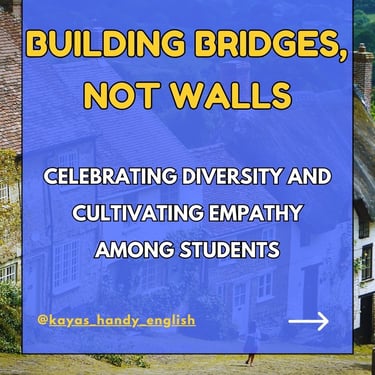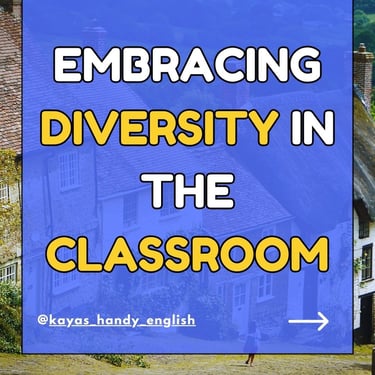[BLOG] Embracing Diversity in the Classroom
Not sure if teaching English is for you? Read this blog post about navigating cultural sensitivity in ESL Teaching and find out!
Kaya
2/27/2024
Please keep in mind that the opinions posted on this blog are my own.
Everybody might have a different experience and opinions, and that's OK.
Navigating Cultural Sensitivity in ESL Teaching: Embracing Diversity in the Classroom
Teaching English as a Second Language (ESL) is a dynamic and enriching experience, especially in today's interconnected world. However, as ESL instructors, it's essential to recognize the diverse cultural backgrounds of our students and approach teaching with sensitivity and respect. Let's delve into the importance of cultural sensitivity in ESL teaching and how it enhances the learning experience for everyone involved.
Embracing Diversity: The Heart of ESL Teaching
In the vibrant mosaic of a classroom, diversity is our greatest asset. Each student brings a unique cultural perspective, enriching discussions and broadening horizons. Embracing this diversity fosters an inclusive learning environment where every voice is valued and respected.
Understanding Cultural Nuances: More Than Just Language
Language is more than words; it's a reflection of culture, history, and identity. As ESL teachers, it's crucial to delve beyond grammar and vocabulary to understand the cultural nuances embedded within the language. Whether it's gestures, customs, or communication styles, recognizing these subtleties enables us to connect more deeply with our students.
Fostering Cultural Awareness: Building Bridges, Not Walls
In a world often divided by differences, ESL classrooms serve as bridges that connect cultures and foster understanding. By incorporating cultural elements into our lessons, such as literature, music, and celebrations, we celebrate diversity and cultivate empathy among students. Through these shared experiences, we break down barriers and build meaningful connections.
Cultural Sensitivity in Practice: Adapting Teaching Methods
Flexibility is key when it comes to teaching ESL with cultural sensitivity. Recognizing that what works in one cultural context may not resonate in another, we adapt our teaching methods to suit the needs and preferences of our diverse student body. Whether it's incorporating visual aids, group activities, or storytelling, we strive to create a learning environment that is inclusive and engaging for all.
Addressing Stereotypes and Biases: Challenging Assumptions
In our journey towards cultural sensitivity, we must confront stereotypes and biases that may exist within ourselves and our students. By encouraging open dialogue and critical thinking, we challenge assumptions and promote a deeper understanding of cultural identities. Through mutual respect and empathy, we create a safe space where everyone feels valued and accepted.
Empowering Students: Amplifying Voices
In the tapestry of our classroom, every student's voice deserves to be heard. By encouraging students to share their cultural experiences and perspectives, we empower them to take ownership of their learning journey. Whether through presentations, projects, or class discussions, we provide platforms for students to shine and celebrate the richness of their heritage.
In the ever-evolving landscape of ESL teaching, cultural sensitivity is not just a buzzword; it's a guiding principle that enriches the learning experience for both teachers and students.
By embracing diversity, understanding cultural nuances, and fostering empathy, we cultivate cultural competence in our classrooms.
Together, let's embark on this journey of discovery, celebrating the vibrant tapestry of cultures that makes our world truly extraordinary.








Get in touch!
Copyright Handy English 2021
”I used this with an adult ELL tutee of mine. I appreciate that the language was accessible for multiple proficiency levels, but the content wasn't obviously geared for children and still useful for older learners.”
August 7, 2023
”Another great resource from Handy English! I used it to give my students more in-depth practise into quantifiers and restaurant language. It's great resource and can be used after the students learn the basics of language for the restaurants and quantifiers. Definitely helped solidify what they learnt.”
February 5, 2023
”Love this resource. Great for fast finishers and also those in small ESL groups. Great for all macro skills as discussion and brainstorming is a great precursor for writing submissions.”
- Gail M.
June 25, 2023
Here's what other ESL Teachers say
Handy English: 4.8/5
”This was a wonderful resource for my students. It helped me introduce them easily to new concepts and it was quite engaging. Thanks!”
- Kiara B.
October 10, 2023
”Great resource for learning vocabulary, which supports comprehension and speaking skills.”
- Lori-Ann W.
September 29, 2023
”What a great way to get a healthy debate going. My students struggle with impulse control and they all have kept it kind and appropriate.”
- Alicia H.
September 17, 2023






